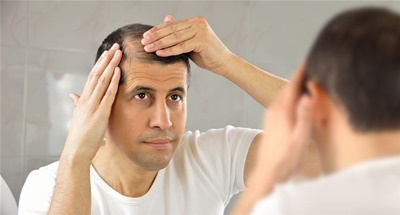 If you’ve started researching ways to treat male-pattern baldness, you’ve almost certainly run across information discussing finasteride vs. minoxidil. You might know them better by a brand name, but they’re two of the most widely discussed – and used – hair loss medications out there.
If you’ve started researching ways to treat male-pattern baldness, you’ve almost certainly run across information discussing finasteride vs. minoxidil. You might know them better by a brand name, but they’re two of the most widely discussed – and used – hair loss medications out there.
This means that if you’re looking for baldness treatments, you’re probably at least considering these medications as a possibility for you. But do they work? What’s the difference between them? And are they really the best choice for you?
Take a look at what you need to know about finasteride (often prescribed as the brand name Propecia) and minoxidil (often prescribed as the brand name Rogaine).
Finasteride to Stop Hair Loss
The purpose of taking finasteride is to stop hair loss from occurring in the first place. A primary cause of hair loss is dihydrotestosterone (DHT). DHT is a male sex hormone that binds to hair follicles and causes them to shrink and gradually stop producing hair. This is a process known as miniaturizing. DHT is created from testosterone – the body converts testosterone into DHT. Finasteride blocks this conversion from taking place to begin with, preventing hair loss. You might see finasteride referred to as a DHT-blocker.
Finasteride has generally been found to be an effective hair loss prevention treatment in studies. People taking finasteride usually are able to at least maintain their current hair growth, showing no visible further loss, and some even see an increase in hair growth. Studies conducted over a period of years show that finasteride does not lose its effectiveness with prolonged use – it continues to work as long as you continue to take it. In order for it to be effective, however, the medication has to be taken on a daily basis. When it’s no longer active in your body, the body will resume converting testosterone to DHT and hair loss will resume.
Finasteride is generally considered to be a safe medication with mild side effects. The most commonly reported side effects include decreased libido and erectile dysfunction. These occur because DHT is a sex hormone, and finasteride blocks it from being created in the first place.
Minoxidil to Promote Hair Growth
The main difference between finasteride vs. minoxidil, is that while finasteride stops hair loss, minoxidil promotes new hair growth. Minoxidil is available as a topical solution that you apply to your scalp.
To understand how minoxidil works, it is helpful to understand the phases of hair growth. Hair has a growing phase, a transition phase, a resting phase, and a new hair phase.
- The growing phase: this is called the anagen phase and lasts for three to five years, during which time hair grows by about half an inch every month.
- The transition phase: this phase, called catagen, is a short one – about ten days on average.
- The resting phase: known as telogen, this phase lasts for about three months. During the time when old hair is in a telogen phase, new hair begins a growing phase.
- Exogen: the last phase is called exogen, and during this phase, the old hair falls out while new hair continues to grow.
Minoxidil is thought to work by widening blood vessels in the scalp area. This allows more oxygen and nutrients to reach the hair follicles. This extra influx of nutrients can kickstart the anagen phase prematurely, causing hair follicles to go throw the growth cycle again.
One important thing to know when starting minoxidil is that you may see some shedding of hair shortly after you start using it. Don’t panic! This occurs because the hair in the resting phase is being replaced by new hairs in the growing phase. While it may be unnerving to see more hair being shed than usual, it’s actually a sign that the minoxidil is working as intended. The lost hair will quickly be replaced with stronger, healthier hair.
Apart from potential shedding, side effects of minoxidil are rare, though not impossible. Some people may experience irritation or redness in the treated area, and if minoxidil gets into your eyes they may redden or feel as if they’re burning. For most people, minoxidil is a safe hair loss treatment.
Finasteride vs. Minoxidil: Which One is Better?
You may be wondering which hair loss treatment is better when it comes to finasteride vs. minoxidil. However, it is hard to say. Both treatments are effective, and both treatments are widely considered safe. Both treatments are also popular among people dealing with hair loss.
They work in very different ways, so it may depend on your specific needs. If you’ve just started to notice that you’re losing more hair than you’re comfortable with, it may be a good idea to start with finasteride to prevent any further hair loss. If your hair loss is already more advanced, then you may benefit more from minoxidil to stimulate new hair growth.
For some people, it may be beneficial to use a combination of finasteride and minoxidil, to both stop hair loss and promote new growth. The medications do not interact with each other, and studies have shown that the combination of finasteride and minoxidil is more effective than either treatment by itself. However, it’s still a good idea to speak to a hair loss doctor about the best treatment for your individual situation. While minoxidil is available over the counter, finasteride requires a doctor’s prescription.
Other Treatment Options
When it comes to finasteride vs. minoxidil, both are effective, safe, and popular hair loss treatments, but they are not the only hair loss treatments available. Depending on the cause of hair loss, other treatments may be a better choice – for example, hair loss caused by the autoimmune disorder alopecia areata is often treated with corticosteroids. There are also a variety of topical treatments and even laser treatments that are thought to stimulate hair growth.
Another popular and effective solution for hair loss is hair transplant surgery. There are a couple of different methods of hair transplant surgery available, and the results can be impressive. If you’re struggling with hair loss and interested in solutions to stop the hair loss or achieve new hair growth, it’s wise to research all of your available options and talk to a medical professional who can assess the reasons behind your hair loss and recommend the treatment that will be most effective for you.

